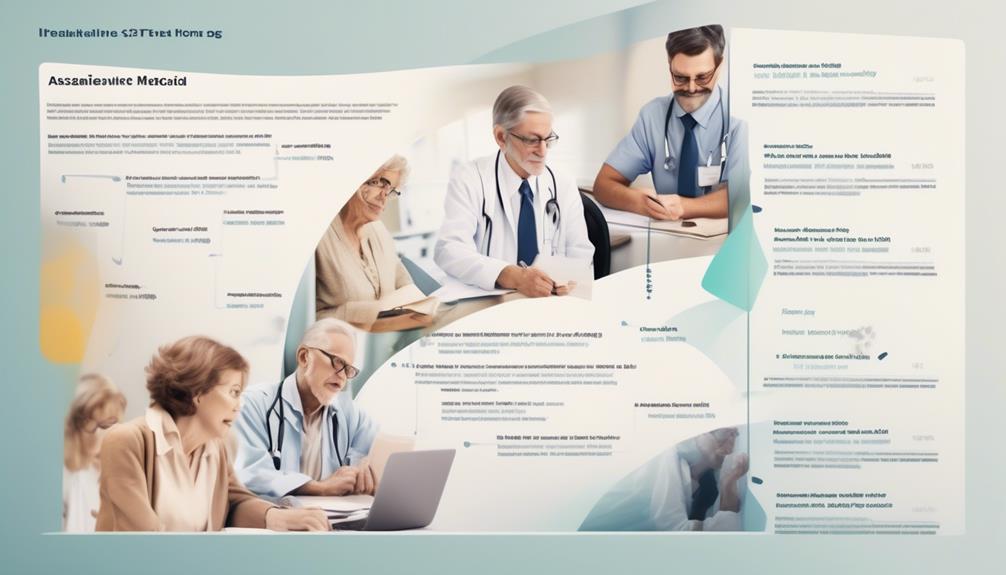When exploring the importance of the Medicaid Look Back Rule, we are examining a critical component of financial planning for healthcare. This rule aims to prevent individuals from transferring assets or selling them for less than their true value in order to qualify for Medicaid long-term care benefits. Having a good grasp of the Medicaid Look Back Rule is crucial for families to avoid penalties and ensure proper planning for their future healthcare needs. Furthermore, discussions around government policy and private insurers often focus on promoting Medicare Advantage plans as an alternative option for retirees seeking extensive coverage.
This regulation has significant implications for individuals seeking Medicaid benefits, especially concerning asset transfers within a specific timeframe.
Understanding the nuances of this rule is essential for anyone navigating the complexities of Medicaid eligibility.
By shedding light on the intricacies of the look-back period, individuals can gain valuable insights into how to safeguard their financial well-being while pursuing necessary healthcare coverage.
Key Takeaways
- Scrutiny of asset transfers within 60 months is crucial for Medicaid eligibility.
- Planning exemptions for transfers to spouse or disabled child are important.
- Compliance with regulations avoids penalties and maintains Medicaid eligibility.
- Seek legal advice for navigating complex asset transfer evaluations effectively.
Overview of Medicaid Look Back Rule
The Medicaid look-back rule provides a mechanism for scrutinizing asset transfers made by applicants within a specified period before applying for Medicaid benefits. This look-back period, typically spanning 60 months, aims to prevent individuals from transferring assets to meet Medicaid eligibility requirements artificially. Any transfers during this timeframe undergo strict asset review, and penalties may apply for non-compliance with the regulations.
Understanding and adhering to the rules governing the Medicaid look-back period are vital for individuals to maintain their Medicaid benefits without facing penalties that could jeopardize their eligibility. While most asset transfers are subject to scrutiny, certain exceptions exist, such as transfers to a spouse or disabled child, which may not incur penalties during the look-back period.
Ensuring compliance with the Medicaid look-back rule is essential for applicants seeking Medicaid benefits to navigate the eligibility process smoothly.
Impact on Medicaid Eligibility

Analyzing asset transfers within the Medicaid Look-Back Rule's designated timeframe is crucial for determining eligibility and avoiding penalties. Under this rule, certain transfers made within the 60-month period before applying for Medicaid can lead to a penalty period during which the individual is ineligible for coverage. Understanding the implications of the Look-Back Rule is essential to maintain Medicaid eligibility. Some transfers, like those to a spouse or disabled child, may be exempt from scrutiny during this period. Proper planning and compliance with the Look-Back Rule are vital to ensure Medicaid coverage without facing penalties.
| Aspects | Details |
|---|---|
| Medicaid Look-Back Rule | Focuses on asset transfers within 60 months before Medicaid application. |
| Penalty Period | Imposed on individuals violating the Look-Back Rule, rendering them ineligible for Medicaid. |
| Exemptions | Some transfers, like those to a spouse or disabled child, may be exempt from scrutiny. |
| Planning | Essential to ensure compliance with the Look-Back Rule and maintain Medicaid eligibility. |
| Scrutiny | Proper planning and understanding exemptions help individuals navigate the scrutiny effectively. |
Financial Transactions Review Process
To understand the impact of the Medicaid Look-Back Rule on financial eligibility, we must delve into the intricate Financial Transactions Review Process. During this period, which typically spans 60 months prior to the Medicaid application date, all financial transactions and asset transfers come under scrutiny by the Medicaid agency.
Any improper asset transfers made during this timeframe can result in penalties that affect Medicaid eligibility. It's crucial to adhere to the regulations surrounding asset transfers to ensure a smooth Medicaid application process and qualification.
The Financial Transactions Review Process plays a vital role in preventing individuals from inappropriately transferring assets to meet the requirements for Medicaid coverage. Understanding the nuances of this process is essential for individuals seeking to navigate the Medicaid eligibility criteria successfully.
Asset Transfer Evaluation Period

During the Asset Transfer Evaluation Period, careful scrutiny is applied to all financial transactions and asset transfers made by the applicant within the 60-month look-back timeframe. This period is crucial in determining Medicaid eligibility, particularly for Nursing Home Medicaid. Any transfers or gifts made during this time can result in a penalty, impacting the individual's ability to receive Medicaid benefits.
It's essential to understand when the look-back period begins, typically aligning with the Medicaid application date. Seeking advice from an Elder Law attorney can provide valuable guidance on navigating this complex process. Proper care should be taken to document all financial transactions and transfers accurately to ensure compliance with Medicaid regulations.
Understanding the implications of asset transfers within the 60-month period is key to avoiding penalties and maintaining eligibility for essential long-term care services.
Strategies to Navigate Look Back Rule
Navigating the Medicaid Look Back Rule effectively requires strategic planning and careful consideration of various asset protection strategies. When devising a strategic spend down plan to comply with the Medicaid look back rule, it is essential to explore options such as caregiver agreements, Medicaid exempt annuities, and irrevocable funeral trusts. Additionally, seeking advice on undue hardship waivers can help address specific circumstances that may arise during the Medicaid planning process. Understanding state-specific rules and exceptions is crucial to ensure proper asset protection and compliance with the Medicaid look back period. To emphasize the importance of these strategies, consider the following table:
| Asset Protection Strategies | Description | Benefits |
|---|---|---|
| Caregiver Agreements | Legally spend down assets without violating the look-back rule | Protect assets |
| Medicaid Exempt Annuities | Part of a strategic spend down plan to navigate the look-back rule effectively | Ensure compliance with Medicaid rules |
| Irrevocable Funeral Trusts | Protect assets from the Medicaid look-back period | Secure funds for funeral expenses |
Frequently Asked Questions
What Is Lookback or Look Back Period?
The lookback period, also known as the look-back period, refers to a specific timeframe, often 60 months before an application date, during which financial transactions are reviewed.
It involves disclosing all asset transfers, gifts, or changes made during this period.
Understanding and adhering to the rules of the lookback period is vital for maintaining Medicaid eligibility and avoiding penalties.
Failure to comply with these regulations can result in repercussions such as ineligibility for Medicaid benefits.
What Is the Look Back Period for Medi-Cal?
When it comes to Medi-Cal, the look-back period typically spans 60 months prior to the application date. This period involves scrutinizing financial transactions and asset transfers within that 5-year timeframe.
Applicants must openly disclose all transfers made during this period. Not adhering to these rules can lead to penalties impacting Medicaid eligibility.
Understanding the Medi-Cal look-back period is crucial for a successful application process.
How Do I Avoid Medicaid 5 Year Lookback in Pa?
To avoid Medicaid's 5-year lookback in PA, we must carefully plan asset transfers in line with Medicaid regulations. Documenting transfers properly is crucial to show compliance.
Seeking guidance from a Medicaid planning expert can help navigate this period effectively. Avoiding significant asset gifts or transfers within 5 years of applying is key.
Understanding PA's Medicaid rules and exceptions is essential to sidestep the 5-year lookback requirement.
How Do I Protect My Assets From a Nursing Home in Texas?
We protect our assets from a nursing home in Texas by understanding Medicaid's rules, openly disclosing asset transfers, and seeking legal advice to ensure compliance.
Proper planning and consultation with an Elder Law attorney can safeguard assets and navigate the complexities of Medicaid eligibility.
Conclusion
In conclusion, navigating the Medicaid Look Back Rule is essential for maintaining eligibility and avoiding penalties. It's like walking a tightrope – one wrong move can lead to consequences.
By understanding the impact on eligibility, the review process, and evaluating asset transfers, applicants can strategize effectively.
Staying informed and compliant with the regulations of the look-back period is crucial for a successful Medicaid application process.










